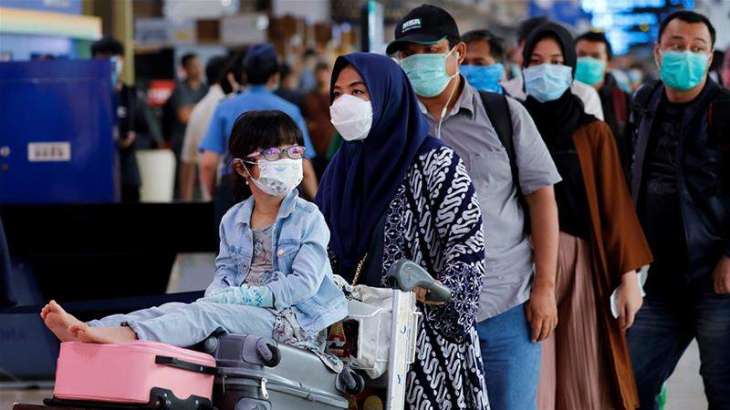In mid-June 2020, Europe sighed with relief and numerous prominent doctors and experts said that the pandemic was ending
BRUSSELS (Pakistan Point News / Sputnik - 25th September, 2020) In mid-June 2020, Europe sighed with relief and numerous prominent doctors and experts said that the pandemic was ending.
In recent weeks, however, the daily increase in the number of COVID-19 cases in EU countries started to grow once more, and the question arose whether Europe is on the verge of the second wave of the pandemic.
At the same time, the terrible economic situation and hence pressure on sectors such as tourism or more simply bars and restaurants, led governments in Spain, Italy, Portugal, Greece and France to re-open borders for tourists and timidly allow public life resume in July and August. Places such as Barcelona, a magnet for young people who want to meet, mingle and have fun after a day at the beach, nearly forgot about distancing measures. Parties involving hundreds of people on the beaches of Spain, Italy or France were organized every night, where, of course, there were next to none social distancing.
The result was delayed, but the return of tourists to Central and Northern Europe, without much control at airports and borders, started to spread the virus among the older population, more at risk; infecting parents and grandparents, who were also more lax with distancing measures.
Three months of carelessness and hesitation by the authorities, afraid to be too unpopular with confinement measures, allowed the epidemic to start again.
Over the past several weeks, there has been a variety of expert assessments. Many were ringing the alarm bell but others explained that the increase in the number of cases was not exponential and that the infection rate was barely at 1:1. By September 25, however, the situation has much worse in such countries as Spain and France, and there are also six other countries where the situation is even worse than in Spain.
The European Commission called the EU member states on Thursday to toughen restrictive measures "immediately" in the face of the risk of the second wave of the pandemic. European Health Commissioner Stella Kyriakidou warned that "this may be our last chance to avoid a repetition of the situation of last spring."
Seven EU countries, namely Spain, Romania, Bulgaria, Croatia, Hungary, Czech Republic and Malta are experiencing an evolution of the pandemic causing great concerns and increased risks of mortality.
The warning is echoed by the World Health Organisation that has announced that the COVID-19 pandemic has killed 1 million people in the world since first cases were reported in December 2019. In total, nearly 32 million cases of the infection have been officially diagnosed. The United States is the most affected country in terms of both deaths and cases, with 201,910 deaths for 6,934,233 cases.
After the United States, the most affected countries are Brazil with 139,808 victims, India (91,149), Mexico (74,949) and the United Kingdom (41,862), followed by the rest of Europe.
There is still no common approach in Europe, where each member state decides on its own health policy. It is only in September that member states managed to harmonize their definitions of the health zones, from green to red, but maps diverge again, since each country follows only certain measures and not the others.
In Belgium, for instance, the contamination rate has strongly increased again and the number of hospitalizations has tripled in 2 weeks. Official figures show an acceleration in contamination since the start of the school year, but the Belgian authorities are adopting a strategy completely different from France or Spain, which are tightening the screws.
From October 1, wearing a mask outside the Brussels region will only be compulsory in high-traffic areas, despite the fact that Belgium has gone from "dark orange" to "red" zone, according to the European Centre for Disease Prevention and Control.
Belgium will be considerably relaxing anti-coronavirus measures. Prime Minister Sophie Wilmes set the tone at her press conference on Wednesday: "The virus is still there but life must go on!"
Federal Budget Minister David Clarinval, who is also a member of the National Security Council responsible for the COVID-19 measures, told Sputnik that "our aim is to increase adherence to the rules and to make the population more responsible."
"We are not lax, on the contrary. This summer, we imposed much stricter rules than France in many areas. For example, for outdoor events, we limited gatherings to 400 people compared to 5,000 across the border," Clarinval said.
In addition, the quarantine goes from fourteen to seven days. Travelers returning from the red zone will be able to avoid it if, in the questionnaire they fill out, they demonstrate that they have been careful during their stay abroad.
FRANCE AND SPAIN TIGHTENING SCREWS
On Friday, French Minister of Health Olivier Veran abruptly decided, without a consultation, that all public places would be closed for a fortnight in the region of Marseille.
"It's catastrophic," bar and restaurant owners say. They have been shocked by Veran's announcements.
Marseille is in a "deep red" zone, but the majority of French regions are red, including Paris. The head of the Provence-Alpes-Cote-d'Azur region, Renaud Muselier, has announced that he will challenge the government's measure in court. In other large cities, including Paris, gatherings of more than 10 people will be prohibited in public spaces. Cafes, restaurants and bistros now have to close at 10:00 p.m.
Spain is probably the worst-hit by this second wave and the government is desperately trying to avoid re-confinement.
The incidence rate is "very worrying" in the Madrid region. A large part of the capital's population, 850,000 people, is already subject to "mobility restrictions." They must justify any exit from their neighborhood. The measure should be extended to new areas of the region starting from Monday.
In these neighborhoods, mostly located in the poor south of the capital, parks are closed, bars and restaurants must lower their curtain at 10:00 p.m. - which is the dinner time for many Spaniards - and meetings are limited to six people.
The affected areas have more than 1,000 cases of coronavirus per 100,000 inhabitants in the last 14 days. It is an extremely high incidence rate, but not much higher than the already very worrying regional average - 755, compared to 287 in the rest of Spain.
Marc Van Ranst, professor at the KU Leuven university in Belgium and former head of the Belgian Security Council advising the government on the COVID-19 policies, told Sputnik that he was disappointed with lifting of the restrictions in Belgium.
"Now is not the time to soften up! You don't have to be a great virologist to predict that the numbers will increase further in the next few weeks," he said.
According to the Van Ranst, Belgium will face big problems in the coming weeks if the government fails to take action.
"Some measures are excessive, I admit. It is indeed ridiculous that people have to wear masks everywhere, even in places where hardly anyone goes. It is also difficult to maintain a 'bubble' of five people in families. But I hope everyone will limit their contacts in the coming weeks," the professor added.
Another Belgian professor, Jean-Luc Gala, believes that the return of young people from vacation and the return to school and the resumption of social life for students in universities are one of the causes of the growing infection rates.




